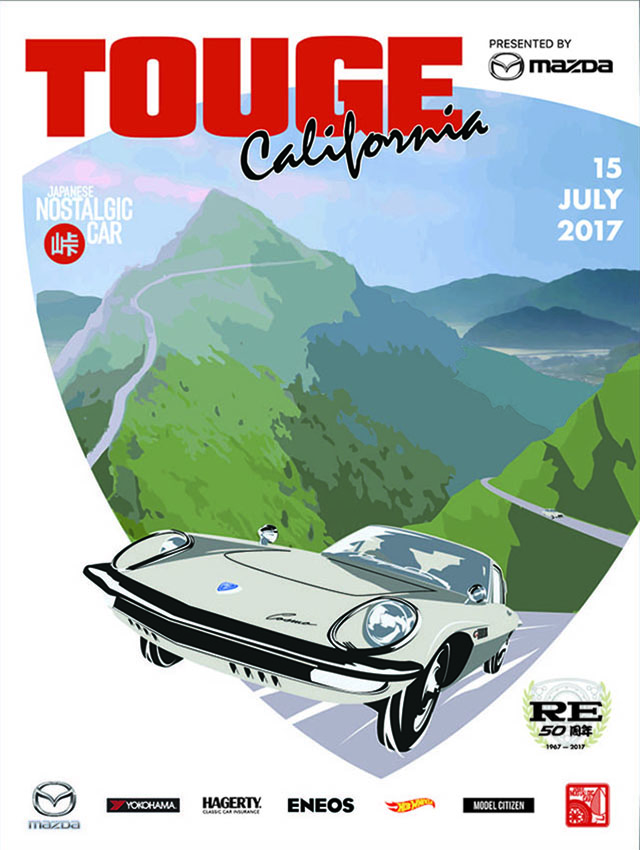
We’ve covered a lot of the early rotary Mazda history, especially the racing history of the Cosmo 110S, Familia Coupe, RX2 Capella and RX3 Savanna GT. It would lead you to believe that Mazda rotaries were all about performance and racing, but in 1975 Mazda took a sharp left turn with the RX-5 (or Cosmo as it was called in Japan).
The RX5 debuted with very Americanised, bloated chrome laden styling, very much like a Japanese Olds Cutlass or Chevy Monte Carlo. In the USA, the muscle car era petered out in the early 70s as all of the old muscle nameplates like the Charger and Mustang were weighed down with power sapping pollution controls and greater weight from customer demands for more “personal luxury”…to the point where former big-cube hero cars were reduced to chrome laden gin palaces for the disco generation that could barely wheeze across the quarter mile in 19 seconds. And so Mazda followed suit with the RX5.
The irony is, the RX5 sold very poorly in the USA (in fact it sold badly in all western markets) but the one market where it was a certified smash hit was Japan.

ABBA-era Japanese customers couldn’t get enough of the RX5 and it sold 55,000 units in its first year, while foreign sales dwindled to the point where the facelifted Series II version was only sold in Japan and so foreign sales were discontinued in 1979. So what is an RX5 anyway?
 Powered by a 135hp 13B rotary (in Japan a 12A was an option) the RX5 also brought with it some new advances. In contrast to its predecessors, it had a 5spd gearbox and disc brakes all round. The rear suspension was still live axle, but located by a proper five link layout with coil springs instead of the leaf springs of the RX3 and RX4. The downside was much greater weight, weighing 1200kg, compared to 890kg for an RX3 and 1000kg for an RX2. Notwithstanding the hardware upgrades, performance suffered and the RX5 was slow. Call it almost 18 seconds for the quarter mile for the manual and 15 seconds 0-100 for the automatic RX5.
Powered by a 135hp 13B rotary (in Japan a 12A was an option) the RX5 also brought with it some new advances. In contrast to its predecessors, it had a 5spd gearbox and disc brakes all round. The rear suspension was still live axle, but located by a proper five link layout with coil springs instead of the leaf springs of the RX3 and RX4. The downside was much greater weight, weighing 1200kg, compared to 890kg for an RX3 and 1000kg for an RX2. Notwithstanding the hardware upgrades, performance suffered and the RX5 was slow. Call it almost 18 seconds for the quarter mile for the manual and 15 seconds 0-100 for the automatic RX5.
 But still the Japanese market lapped them up, and the Cosmo was even awarded “Car of the Year” by quite a few JDM magazines. The Japanese market at the time was very conservative and so the RX5 would have appealed to the average guy or gal who would have bought a Toyota Crown. By being less racy than its predecessors, the Cosmo found a lucrative sports-luxury position in the market that served Mazda well in Japan. In foreign markets, Mazda had found a good niche in the early 70s with its sporty rotary sedans and coupes. However, the fad didn’t last, and in the US especially, sales fell dramatically towards the mid 70s, as the fuel crisis took hold. So the RX5 was an attempt by Mazda to find a new direction with its rotary engine concept, and to give Mazda some credit, it did make some moves in the right direction. In the US, Road Test magazine got an average of 24mpg out of the RX5, whereas its RX4 predecessor had averaged a horrific 16mpg. The 5spd ‘box can take some of the credit, but detail attention to the porting, carby tuning and anti-pollution thermal reactor system was the key.
But still the Japanese market lapped them up, and the Cosmo was even awarded “Car of the Year” by quite a few JDM magazines. The Japanese market at the time was very conservative and so the RX5 would have appealed to the average guy or gal who would have bought a Toyota Crown. By being less racy than its predecessors, the Cosmo found a lucrative sports-luxury position in the market that served Mazda well in Japan. In foreign markets, Mazda had found a good niche in the early 70s with its sporty rotary sedans and coupes. However, the fad didn’t last, and in the US especially, sales fell dramatically towards the mid 70s, as the fuel crisis took hold. So the RX5 was an attempt by Mazda to find a new direction with its rotary engine concept, and to give Mazda some credit, it did make some moves in the right direction. In the US, Road Test magazine got an average of 24mpg out of the RX5, whereas its RX4 predecessor had averaged a horrific 16mpg. The 5spd ‘box can take some of the credit, but detail attention to the porting, carby tuning and anti-pollution thermal reactor system was the key.

While Mazda reacted appropriately to the market pressures at the time, maybe the RX5 was too much of a seachange for foreign rotary fans to embrace. There is probably quite a lot of truth to this, as after the RX5, Mazda went straight back to its sporty rotary roots and released the 1st Gen SA22 RX-7, which for many years was the best selling sports car in the USA….I guess the moral of the story is to stick to what you do best!
So…like any GrandJDM feature car the RX5 Cosmo will have a few racing stories, right? Well….as a matter of fact, yes. But only a few 🙂
In 1976 Z&W Mazda of New York entered an almost stock RX5 into the Daytona 24hrs. Running a stock motor, and just upgraded brake pads, exhaust and a roll cage, it rolled in with an unexpected class win and 18th OVERALL. Hell of an achievement.



In Europe, an RX5 was campaigned in the European Touring Car Championship by John Markey and David Palmer, with sponsorship from Smith Kendon Sweets (you know, the ones you get at the chemist!). In terms of race results, it did ok, but there were no upset wins against its formidable competition of BMW CSLs, Alfa Romeo GTVs, Ford Capri RS’s and Jag XJ12s.

And…that’s the story of the RX5 really. Fans of the model (yes, both of you) may wince at this suggestion, but in hindsight it can perhaps be said that the greatest contribution of the RX5 Cosmo was that it prompted Mazda to stick to what it did best. What followed was the SA22 RX7, a car that gave the rotary engine concept a new lease of life that has lasted until the present day.
In this day and age when everything 70s is suddenly cool again, personally, I think that perhaps the time of the RX5 Cosmo will come. It may be 30 years too late but maybe the CD Cosmo may find coolness after all…
Finally, some videos! The first one is a movie I think, a cop-car chase featuring the very rare convertible version of the RX5:
This one’s a TV commercial for the series II Cosmo (which wasn’t sold outside of Japan and is very differently styled to the Series Is pictured in the article above)
This one’s for the original series I RX5 that was sold internationally (can you feel the disco beat?):






I’ve tried many times to see some redeeming features in the visual design of this car, but I just get nothing!
You know that little rectangular window in the b pillar winds up and down? It’s called Opera Window 🙂
Count me as one of the fans of this “heavy”, “slow” rotary.
One of my friends is a huge fan of the RX-5 and a vigorous defender of their perceived “flaws”, namely their allegedly high weight and lack of performance. He says that kilo-for-kilo an RX-5 is a better assembled, stiffer, better handling RX-4 coupe. Swapping in a sensibly-chosen diff ratio fixes most of the “slowness” (RX-5s are 3.7 or taller, RX-4s and earlier are 3.9) and porting the engine and ditching the REAPS exhaust system for extractors finds the power that Mazda hid (hides? Even early RX-7s are comparatively choked).
Van, you have to think of the RX-5 as Baroque or even Rokoko. From the R100 to the RX-4 every rotary got chintzier and more elaborate with more chrome and fiddly details. With the RX-5, I think they eventually got around to saying what they were trying to say. It’s very American, in that Boat-tailed Buick Riviera way.
I’ve always loved RX5s! Weren’t they sold in Aus as 121’s as well?
Yes they were. And in fact I think that the regular 4cyl 121 continued to be sold in foreign markets after the rotary version was confined to Japan only.
I agree with Ben, I like the RX5 too, if only in an “ironic” way (ie it looks like a smaller Lincoln Continental but can be made to sound and perform like an RX7). But stylistically, I think that any treatment that works well for a JDM sedan of the same era can work well on an RX5.
Here are some nicer ones.




Here’s a pretty mint looking one (low miles too) for sale in Japan:
http://www.j-spec.com.au/list/index.php?ID=11233
Series II model too, not sold outside of Japan.